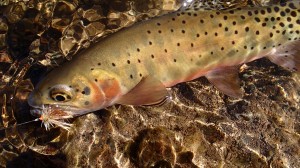In late December, a bill to permanently protect the Hermosa Creek watershed—a major Trout Unlimited focus area for conservation—received final approval in the U.S. Senate and proceeded on to President Obama for his signature. It was a great day for our local Durango community, for Colorado and for America’s backcountry fanatics.
The Hermosa Creek Watershed Protection Act, along with a handful of other public land bills, was attached as riders to the National Defense Authorization Act – a “must pass” piece of legislation. As a result, Congress finally got this important piece of legislation across the finish line.
Native cutthroat trout in southwest Colorado now have a protected home in America’s newest wilderness area!
We are grateful for Sen. Michael Bennet and Rep. Scott Tipton and staff, for helping bring the Durango community together and working hard to get this done.
The passage of the bill represents eight years of work by TU staff from the Sportsmen’s Conservation Project and Colorado Water Project, and volunteers from the Five Rivers Chapter in Durango, CO. The effort has truly been a “One TU” success. But it was not just TU members who fought to protect the Hermosa Creek area for the next generation. Anglers were joined by sportsmen from the region, and across the country, in a coalition aptly named “Sportsmen for Hermosa.” From the local fly shops to rod manufacturers, from sportsmen’s conservation groups to outfitters, sportsmen stood up unified in support of permanent protections for Hermosa Creek. And Congress heard our voices loud and clear!
The Hermosa Creek watershed, just north of Durango, contains Colorado’s largest, unprotected roadless area and is treasured by hunters and anglers for its opportunity and ease of access. For fly fishermen and women, Hermosa Creek is the go-to location in southwest Colorado to cast summer dry flies to pure Colorado River cutthroat trout, brookies and rainbows. For fall big game hunters, Hermosa’s elk beckon with bugles that raise the hair on your neck with excitement and anticipation. Deer, turkey and grouse round out the quarry. Sportsmen were joined in the effort to protect Hermosa Creek by mountain bikers, off-highway vehicle enthusiasts, hikers, backpackers, photographers, horsemen, water concerns, grazers, ranchers and citizens of the region.
It was a bumpy road along the way. In September, the bill received a mark-up in the House of Representatives. To the surprise of everyone back in Colorado, the bill was substantially amended by the House subcommittee. Though it was watered-down and failed to provide the “teeth” of conservation we desired, it passed. Whereas the bill once enjoyed complete and uncontested support, there now was significant opposition, including from TU and sportsmen.
Thankfully, the utter disappointment of the House mark-up and amendments brought about change. Locals made it clear the bill was not OK and needed to return to the original version. In mid-November a deal was struck between the Senate and House subcommittees. The amended bill now was much, much closer to the original version and regained the support of locals back home. In late November the bill received a full House vote (via the defense bill) and passed 300-119.
It’s notable, too, to mention four other TU-led initiatives passed alongside Hermosa and were signed into law. They include the Columbine-Hondo wilderness in New Mexico and the Pine Forest Range in Nevada. We share this victory with our brethren in nearby states.
With that, we raise our glasses in celebration. To pass a public lands protection bill, with a wilderness component, is an astronomical feat in today’s tough and highly partisan political climate. But sportsmen stood strong, made their voices heard, and were persistent and patient—and now 107,000 acres of public land perfectness will remain unspoiled and productive for the next generation of America’s sportsmen, women and children.
---Ty Churchwell, Backcountry Coordinator, Sportsmen's Conservation Project tchurchwell@tu.org










